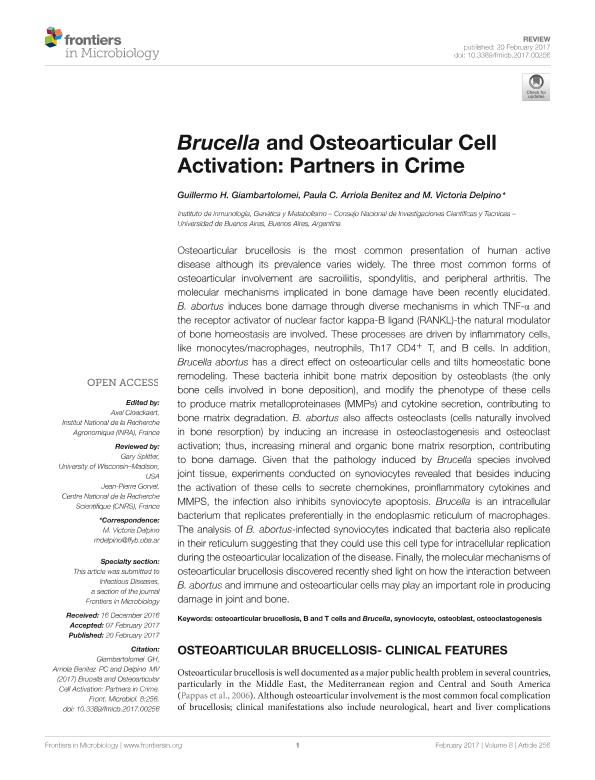Artículo
Brucella and Osteoarticular Cell Activation: Partners in Crime
Fecha de publicación:
02/2017
Editorial:
Frontiers Research Foundation
Revista:
Frontiers in Microbiology
ISSN:
1664-302X
Idioma:
Inglés
Tipo de recurso:
Artículo publicado
Clasificación temática:
Resumen
Osteoarticular brucellosis is the most common presentation of human active disease although its prevalence varies widely. The three most common forms of osteoarticular involvement are sacroiliitis, spondylitis, and peripheral arthritis. The molecular mechanisms implicated in bone damage have been recently elucidated. B. abortus induces bone damage through diverse mechanisms in which TNF-α and the receptor activator of nuclear factor kappa-B ligand (RANKL)-the natural modulator of bone homeostasis are involved. These processes are driven by inflammatory cells, like monocytes/macrophages, neutrophils, Th17 CD4+ T, and B cells. In addition, Brucella abortus has a direct effect on osteoarticular cells and tilts homeostatic bone remodeling. These bacteria inhibit bone matrix deposition by osteoblasts (the only bone cells involved in bone deposition), and modify the phenotype of these cells to produce matrix metalloproteinases (MMPs) and cytokine secretion, contributing to bone matrix degradation. B. abortus also affects osteoclasts (cells naturally involved in bone resorption) by inducing an increase in osteoclastogenesis and osteoclast activation; thus, increasing mineral and organic bone matrix resorption, contributing to bone damage. Given that the pathology induced by Brucella species involved joint tissue, experiments conducted on synoviocytes revealed that besides inducing the activation of these cells to secrete chemokines, proinflammatory cytokines and MMPS, the infection also inhibits synoviocyte apoptosis. Brucella is an intracellular bacterium that replicates preferentially in the endoplasmic reticulum of macrophages. The analysis of B. abortus-infected synoviocytes indicated that bacteria also replicate in their reticulum suggesting that they could use this cell type for intracellular replication during the osteoarticular localization of the disease. Finally, the molecular mechanisms of osteoarticular brucellosis discovered recently shed light on how the interaction between B. abortus and immune and osteoarticular cells may play an important role in producing damage in joint and bone.
Palabras clave:
Brucella
,
Osteoarticular
Archivos asociados
Licencia
Identificadores
Colecciones
Articulos(INIGEM)
Articulos de INSTITUTO DE INMUNOLOGIA, GENETICA Y METABOLISMO
Articulos de INSTITUTO DE INMUNOLOGIA, GENETICA Y METABOLISMO
Citación
Giambartolomei, Guillermo Hernan; Arriola Benitez, Paula Constanza; Delpino, María Victoria; Brucella and Osteoarticular Cell Activation: Partners in Crime; Frontiers Research Foundation; Frontiers in Microbiology; 8; 2-2017; 1-9
Compartir
Altmétricas




